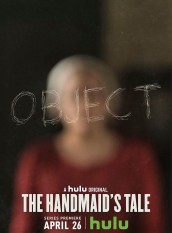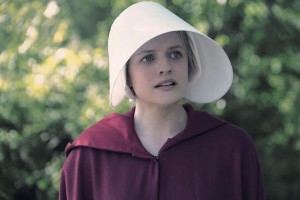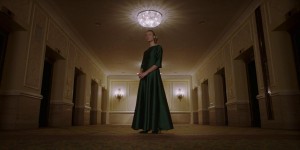The ten-episode first season of Hulu’s THE HANDMAID’S TALE, now available its entirety, has been nominated for eleven primetime Emmy Awards, including Outstanding Drama Series (update: it won). Adapted from Margaret Atwood’s novel, THE HANDMAID’S TALE takes place in a near-future where no women have autonomy, and those few who are fertile are forced to be “handmaids,” childbearers for sterile upper-class couples. The story is seen through the eyes of June, played by Elisabeth Moss (who also won an Emmy for her work here), who outwardly complies but is ever hopeful for an opportunity to break free.
Reed Morano directed the pilot for THE HANDMAID’S TALE, which earned her another of the show’s Emmy wins, and helmed two other episodes as well. Morano, who comes from the world of cinematography, was also up for a cinematography Emmy for her work on the pilot of HBO’s DIVORCE. Originally from Omaha, Nebraska, Morano has also directed the feature MEADOWLANDS and episodes of BILLIONS and HALT AND CATCH FIRE, as well as a new film due out next year.
ASSIGNMENT X: Do you approach a story visually first, or narratively?
REED MORANO: I actually approach a story narratively first. I think I always approached the story narratively, even when I was exclusively doing cinematography. Any time I read a script that I maybe could shoot, I was always looking for, what’s the best story? I knew THE HANDMAID’S TALE already, I knew the book, I loved the book. You can get lost in it. And I thought, “This is an opportunity to create that world, and make the audience get lost in it.” So first, I’m thinking, “This is such an interesting story.” And secondarily, I’m like, “Well, actually, there are a lot of really cool visual opportunities on top of great roles and performances to play with.”
AX: Why did you only do the first three episodes?
MORANO: I have a movie that I’m doing [I THINK WE’RE ALONE NOW], so sadly, I’m only doing the first three, but I really enjoyed it. There was an option that I could just do the pilot, but they asked me to do the first three, and I was like, “I’ve got to do the first three.” having also d.p.ed [been director of photography on] a lot of TV shows as well, I know how often, if the director is not the through-line, from the pilot to the second episode, there can be a huge disparity and change in style or tone. And it really was important to me to keep the tone going that I wanted for the show as long as I could. And so I thought, the longer I can work with the actors, the longer I can work with the cinematographer, Colin Watkinson, and Ane Crabtree, the amazing costume designer, the more I could work with all of them, the more we would be on the same page, and then when I left, it would be like, let my baby birds fly from the nest, and hopefully it goes well. And they brought great other directors on, and they were all so inspired by the pilot and everything in the other episodes, so they were chomping at the bit to try it. And I think it’s good [to have the] creative variety of the other directors coming in.
AX: There are a lot of scenes where June has voiceovers. Did you direct Elisabeth Moss differently for those than you did in scenes where the dialogue is all onscreen?
MORANO: I think Lizzie and I fell into a rhythm about how we were going to approach those scenes. The only difference is, when I knew there were going to be voiceover, I had to think editorially and in a cinematography way as well, or editorially and narratively, how am I going to sustain all of this voiceover? Because normally, in a moment, you just see the actor’s expression on their face, but in this show, there are a lot of moments where there is some long voiceover, and it actually challenges you to see the scene in a different way and almost shoot it [in your mind]. So a lot of details she sees and the things that are resonating with her, we had to shoot a lot of additional things to create a visual background for thoughts.
AX: Where did you shoot THE HANDMAID’S TALE?
MORANO: Toronto.
AX: Some scenes have extreme violence, like an accused rapist who is kicked to death by the handmaids, and some scenes have some unusual sexual activity, like the fertilization rituals. Do you deal with your actors any differently for those than you would in a scene where there isn’t some kind of physical activity that everybody has to be careful about?
MORANO: Well, you have to be prepared when you’re doing a scene with a lot of action or a scene with a lot of sex. For me personally, I take more time blocking the scene with the actors. It goes a little bit slower, because you’re trying to be sensitive. The actors are going to have questions, I’m going to have questions. So we just get in the room, and we talk about what we all think it should be, and then we try some things out. So it ends up taking a little bit longer, and then we bring in the rest of the crew to see, and as far as scenes of violence, or scenes with stunts, then we get the stunt coordinator involved, and we had this amazing stunt coordinator on our show, Shelley Cook, who is a female stunt coordinator and a total badass. So anyway, yes. It just takes a little more time and sensitivity. Adam [Winlove-Smith] is a stuntman who is also an actor, and I picked him [to play the rapist who gets kicked to death], and I’m so glad I did, because he was incredible. I just thought he did such a great job. He had nothing he could say, and he really took a beating from those women.
AX: I don’t know if you discussed this with Hulu, but a lot of their original programming slate this year involves women whose sexuality is being exploited. NATIONAL TREASURE is about rape, and HARLOTS is about a broadly coercive situation, and then there’s THE HANDMAID’S TALE. Do you think this is a comment on what’s happening in the world right now, do you think it’s a call to action …?
MORANO: I think it’s both. I think it might be a coincidence, but I don’t know. Hulu is very smart. They’re really putting a lot of thought into the shows that they’re deciding to pursue, and I know, because I’ve pitched shows to them, even after I was on HANDMAID’S TALE, so I know what they’re looking for. I know they have a plan, and a trajectory, so I don’t know that it’s coincidence, but I do think that it’s a call to action, and I do think it’s what the world is asking for. We want more female stories. And so I think Hulu wants to give that. They have a lot of smart people at the helm. And I appreciate it, too, because it’s really nice for me to be able to tell a story where the women are the leads. We have amazing male actors in there who, when they come in, they bang it out, their scenes are so great. But it’s great being with a bunch of actresses on set, and we know that this story will be exciting, not only to women, but to men as well, because it’s dark, it’s dangerous, it’s funny, it’s emotional, and it’s pushing boundaries. And it can appeal to everybody. We can pass the Bechdel test. So it’s really fun. And I feel really fortunate to be working on it with them, and be able to make this statement. And also just to help bring Margaret Atwood’s story to life. She’s a legend.
AX: And is a challenge or is it fun to have the color palette for the series somewhat dictated before you get there, as far as the handmaids all wear red, and the wives all wear blue?
MORANO: I didn’t let it stop me. There are many ways we can go. As a cinematographer, I’ve always appreciated all the different shades of a color, and I knew there were many ways I could go with the red, and many ways I could go with the blue. And I also knew what worked on the Alexa [camera] and on digital in general, so I thought, “I want to make the color as close to the color as I really want it to be in the end, so we don’t have to screw with it too much in post.” And also, I just love those two colors together. So really, at the end of the day, I was just like, “I want to see those two colors together.”
I don’t know what you would call that [exact shade of] red. I should ask Ane Crabtree, who’s my costume designer – she’s amazing. She and I were right on the same page about everything. The red was very clear to me and here, and Elisabeth also picked the red with us. So it was basically me, Bruce, Ane and Elisabeth conferring about it. It’s a very deep red, almost bordering between magenta and maroon. It has a little bit of pink in it, but it also has a little bit of orange, so it’s a great, neutral red that’s pleasing in every situation.
AX: What’s your movie about?
MORANO: My movie is called I THINK WE’RE ALONE NOW, and it’s starring Peter Dinklage and Elle Fanning. It’s a post-apocalyptic movie about a recluse who’s actually pleased that everyone’s gone, he’s sort of created a utopia for himself in his town, and then one day, his peace is disturbed by another survivor. So Peter Dinklage is the main character, and Elle Fanning comes in. So it’s sort of dark and funny and emotional, and it’s a drama as well, so it’s got a little bit of everything.
AX: And what would you most like people to know about THE HANDMAID’S TALE?
MORANO: What I most would like people to know about THE HANDMAID’S TALE is that it’s not going to be what you expect. So you should probably watch it [laughs].
This interview was conducted during Hulu’s portion of the Television Critics Association (TCA) press tour.
Related: THE HANDMAID’S TALE Elisabeth Moss on the new Hulu series – Exclusive Interview
Related: THE HANDMAID’S TALE: Actress Yvonne Strahovski – exclusive interview
Follow us on Twitter at ASSIGNMENT X
Like us on Facebook at ASSIGNMENT X
Article Source: Assignment X
Article: THE HANDMAID’S TALE: Exclusive Interview with Director Reed Morano on the acclaimed Hulu series
Related Posts:













